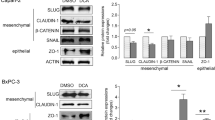Summary.
The natural polyamines are multifunctional constituents of all eucaryotic cells. The objective of this work was to compare aspects of polyamine metabolism in two related cell lines with the idea to investigate whether metabolic differences can be attributed to functional differences of the cells. The human colon carcinoma-derived cell lines SW480 and SW620 were chosen as models. SW480 cells were isolated from the primary tumour, SW620 cells from a lymph node of the same patient. SW620 cells grow faster, and the key regulatory enzymes of polyamine biosynthesis (ODC and AdoMetDC) are more active in the metastatic cells. Moreover, their ability to accumulate polyamines from the environment is more important than of SW480 cells. Likewise polyamine concentrations were markedly higher in SW620 cells, although they are much smaller than SW480 cells, and have a particularly small cytoplasmic space. Both cell lines show a striking diminution of ODC and AdoMetDC activities and changes in the polyamine patterns at the transition from exponential to non-exponential growth – most probably as a consequence of high cell density. Depletion of putrescine and spermidine due to inactivation of ODC by DFMO causes accumulation of cells in G1, and a proportional decrease of S-phase cells in both cell lines. Based on morphologic and other criteria SW480 and SW620 cells were typified as poorly differentiated. In agreement with their low grade of differentiation they exhibit a low alkaline phosphatase activity. However, the time-dependent decrease of alkaline phosphatase is not typical of differentiation patterns of other adenocarcinoma-derived cell lines or of normal enterocytes. The high capacity of de novo polyamine biosynthesis and of polyamine uptake is presumably a prerequisite for the rapid growth and invasiveness. The fact that these properties were more accentuated in the case of SW620 cells and paralleled enhanced metastatic properties indicate relationships between basic parameters of polyamine metabolism and malignancy.
Similar content being viewed by others
Author information
Authors and Affiliations
Additional information
Received May 15, 2002 Accepted June 27, 2002 Published online November 14, 2002
Authors' address: Nikolaus Seiler, IRCAD, 1, place de l'hôpital, BP 426, F-67091 Strasbourg Cedex, France, Fax: (33) 3 88 11 90 97, E-mail: nikolaus.seiler@ircad.u-strasbg.fr
Abbreviations: AdoMetDC S-adenosylmethionine decarboxylase; dAdoMet decarboxylation product of S-adenosylmethionine; DFMO (D,L)-2-(difluoromethyl)ornithine; ODC ornithine decarboxylase; PAO polyamine oxidase (FAD dependent)
Rights and permissions
About this article
Cite this article
Duranton, B., Holl, V., Schneider, Y. et al. Polyamine metabolism in primary human colon adenocarcinoma cells (SW480) and their lymph node metastatic derivatives (SW620). Amino Acids 24, 63–72 (2003). https://doi.org/10.1007/s00726-002-0333-5
Issue Date:
DOI: https://doi.org/10.1007/s00726-002-0333-5




